Original URL: https://www.theregister.com/2011/09/27/oracle_sparc_t4_chip_servers/
Oracle rises for Unix server push
SPARC T4 systems: Same skins, new brains
Posted in Channel, 27th September 2011 01:05 GMT
Oracle is taking the fight to Unix market leader IBM with its eight-core SPARC T4 processor and systems with rack, blade, and clustered systems – a full data center press.
The SPARC T4 processors, with an S3 core, were developed under the code-name "Yosemite Falls" and offer better performance than Oracle expected. They will be included in standalone rack and blade servers as well as in SPARC SuperCluster configurations that mimic the Exadata parallel database and Exalogic parallel application serving system, built on Intel x86 processors and running Linux.
The SPARC SuperClusters, which El Reg will discuss in detail in a separate story, are based on Solaris 10 or 11, and have sophisticated tunings in the Solaris and 11g database stack to make Oracle databases like an Exadata machine on the SPARC servers.
For now, let's just stick to the processor and the four servers that will be based on it. Many of the technical details of the SPARC T4 processor were divulged at the Hot Chips 23 conference at Stanford University (where Sun Microsystems was born) back in August.
The clock speeds of the processors were not divulged, but Oracle has been able to rev them up to 2.85GHz and 3GHz in the SPARC T4 systems, 73 and 82 per cent faster respectively than the previous 16-core SPARC T3 processors, which ran at a much slower 1.65GHz.
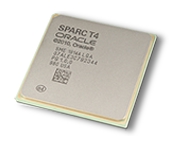
Oracle's SPARC T4 processor
While those SPARC T3 chips had eight threads per core (using the older S2 cores) and did a reasonable amount of work on some applications (like database, Java, and application serving), single-threaded code did not perform particularly well. So with the S3 cores, Oracle's chipheads added dynamic threading (in contrast to the static threading in the S1 and S2 cores) and also added something called the critical thread API. This allows applications to hog all the resources on an S3 core to boost the performance of a single-threaded application.
The SPARC T4 can switch between the thread-hog and normal modes on the fly. However, it is still unclear if recompilation will be necessary for this thread-hogging or will be done automatically. Hopefully, and almost certainly, it is the latter.
On the SPECint2006 benchmark, the SPARC T4 processor running at 3GHz has about five times the performance of the SPARC T3 chip running at 1.65GHz.

Larry Ellison can make the Sun rise again, apparently
The SPARC T4 processor has two DDR3 memory controllers, two PCI-Express 2.0 x8 peripheral controllers, and two 10 Gigabit Ethernet controllers on the die along with eight S3 cores. Each of those cores supports out-of-order execution and all the new threading, with eight threads per core, and also supports 18 cryptographic and hashing functions. Each S3 core has its own 16KB L1 instruction and 16KB L1 data cache, plus its own 128KB of L2 cache; the eight cores share a 4MB on-chip L3 cache, which is broken into two banks. Each core has its own floating point math unit as well.
At the launch event on Monday in San Francisco, Ellison gave a lecture of sorts on the benefits of parallel processing and how the parallel nature of Oracle's software, the SPARC T4 machines, the Exadata storage servers, and the InfiniBand network that glues it all together made the machines extremely scalable and fault tolerant.
But Ellison also reminded everyone that Oracle was also interested in selling standalone SPARC T4 systems and that the "gigantic step" in single-threaded performance on single machines would allow Oracle to upgrade its vast SPARC/Solaris server base.

Oracle CEO and co-founder Larry Ellison
"We wanted to give them a very, very smooth upgrade path," Ellison said. And as John Fowler, executive vice president of hardware engineering at Oracle, said later in the SPARC T4 rollout, Oracle is supporting both the current Solaris 10 and the impending Solaris 11 on these machines to also help in smoothing out that transition.
Oracle has not yet divulged pricing details on the SPARC T4 systems, but if it is aggressive with pricing – meaning keeping the machines about the same price or at a slight premium over the SPARC T3 machines – then it will certainly get the attention of SPARC/Solaris customers. It could also attract a few HP-UX and AIX shops too, if their workloads are modest enough to fit in a system with one, two, or four sockets. A SuperCluster is a bit of a harder sell than pushing an SMP or NUMA machine, but is becoming less so as every year goes by.
Same rack and blade skins, new T4 brains
Oracle has announced four new servers (three rack and one blade - no tower as usual) with the launch of the SPARC T4 processor, and they bear some resemblance to the SPARC T3 systems that came out a year ago. They have perfectly obvious and sensible names, as did the SPARC T3 systems, for which Oracle should be commended.
The SPARC T4-1 is a 2U rack server that can have a single SPARC T4 chip, in this case running at 2.85GHz with all eight cores fired up.
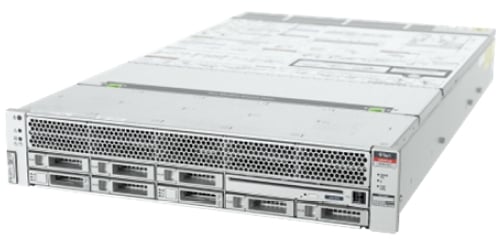
The SPARC T4-1 rack server
This machine has 16 memory slots and supports 4GB, 8GB, or 16GB DDR3 memory sticks, for a maximum capacity of 256GB. That's as much memory as IBM is supporting in its two-socket Power 730 and Power 740 servers and double that supported on its single-socket Power 710 and 720 machines, by comparison.
Of course, IBM is not yet officially supporting 16GB DDR3 memory sticks, which is why it is showing half the memory capacity per socket as the SPARC T4 systems. This will no doubt change when the Power7+ processors are launched in October or November of this year.
The SPARC T4-1 comes with four Gigabit Ethernet ports and you need to add expansion cards to hook 10GE ports onto those two integrated 10GE controllers on the SPARC T4 chip. It has six PCI-Express 2.0 peripheral slots, but the spec sheet doesn't say what they are (probably two x4s and four x8s). The server has room for one slimline DVD drive and eight disk or solid state drives in a 2.5-inch form factor. Oracle is supporting 300GB and 600 SAS or 100GB and 300GB SSD drives in the machine.
The SPARC T4-2 is a two-socket server that comes in a 3U rack chassis. This machine also has a SPARC T4 chip running at 2.85GHz and can cram 128 threads in a single system image.
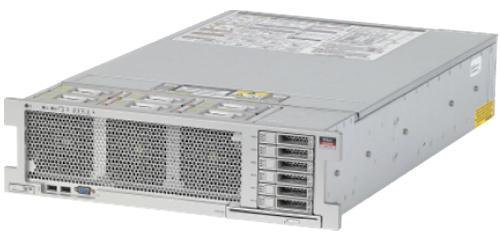
The SPARC T4-2 rack server
The two-socket SPARC T4 machine has double the memory slots to match the doubled up processor sockets, yielding a maximum main memory of 512GB using the 16GB DDR3 memory sticks. Skinnier, and cheaper, 4GB and 8GB memory is also available on the SPARC T4-2.
Because of the extra airflow needed to cool the SPARC T4-2 server (it is cramming twice the memory and processors in only 50 per cent more space), this machine only has room for six 2.5-inch drives, which run down the right side of the box, leaving most of the front open to suck in air to cool the system.
The machine has four Gigabit Ethernet ports on the system board, and you can add four 10GE ports (two per processor) to the system through adapter cards that hook back into the processors. This machine has a total of ten PCI-Express 2.0 slots (two x4 and eight x8). There's a slim DVD in the system as well.
The largest of the new SPARC T4 servers – and the one that is used in the SuperCluster configuration – is the SPARC T4-4, which is, as the name suggests, a four-socket machine. This one is getting the slightly peppier 3GHz SPARC T4 chips, and using them, Oracle can put 256 threads and up to 1TB of main memory into a single system image.
As you can see from the chassis design, it is really two SPARC T4 motherboards glue together into a single image:
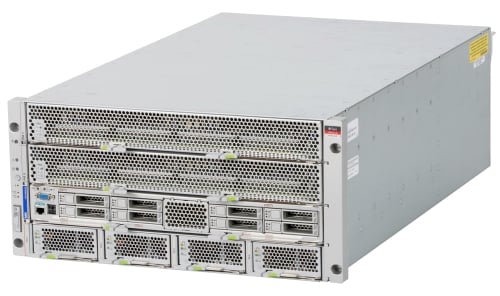
The SPARC T4-4 rack server
The SPARC T4-4 comes in a 5U rack chassis that has four Gigabit Ethernet ports on the motherboard. Interestingly, only two of the eight on-chip 10GE ports can be accessed by adding adapter cards to the system board. The chassis has room for eight disk or solid state drives and has a total of sixteen x8 peripheral slots running at the PCI-Express 2.0 speed.
That leaves the blade server for the Sun Blade 6000 chassis, which is called the SPARC T4-1B, obviously.
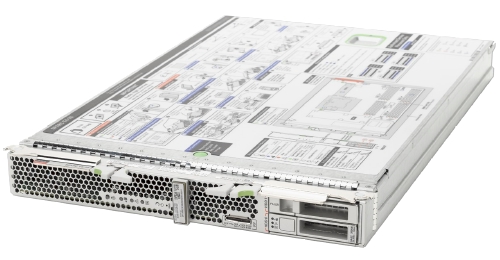
The SPARC T4-1B blade server
This blade server has a single socket and uses the slightly slower 2.85GHz SPARC T4 chip. It sports sixteen memory slots, for a total of 256GB of memory if you pay for the pricey and chubby 16GB sticks. The blade has two on-board Gigabit Ethernet ports and can have two of those 10GE adapters to access the on-chip networking, just like the other SPARC T4 machines. The blade has room for two small form factor disks, and you are restricted to 300GB or 600GB SAS drives or 100GB SATA SSDs.
You need Solaris 10 at the 8/11 update level or Solaris 11 to use these four SPARC T4 servers; you need the Oracle VM Server for SPARC 2.1 hypervisor if you want to virtualize the machine. (You can do granularity as fine as one VM per thread in the machines.)
The SPARC T4 systems are available now, with prices ranging from an entry SPARC-1 at $16,000 with Solaris and the Oracle VM for SPARC hypervisor (also known as Logical Domains or LDoms) included all the way up to a SPARC T4-4 with 1TB of memory that runs $160,000. ®